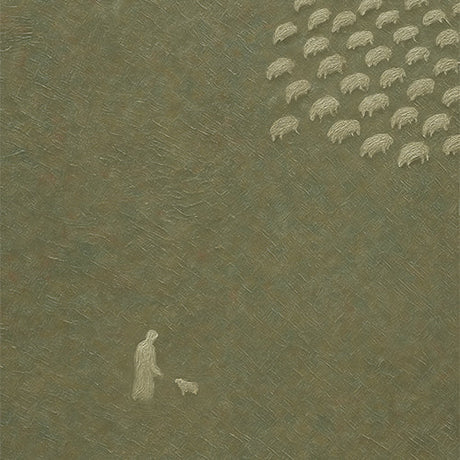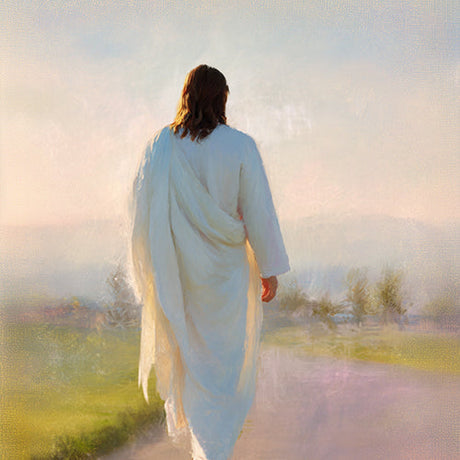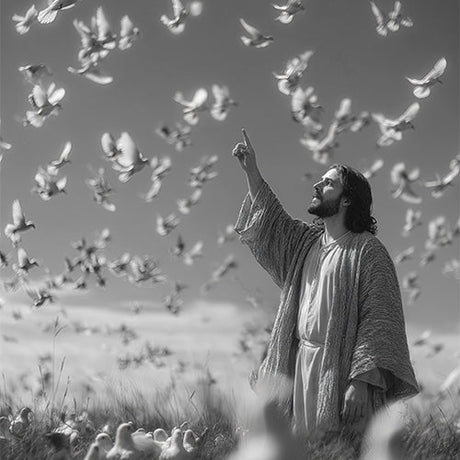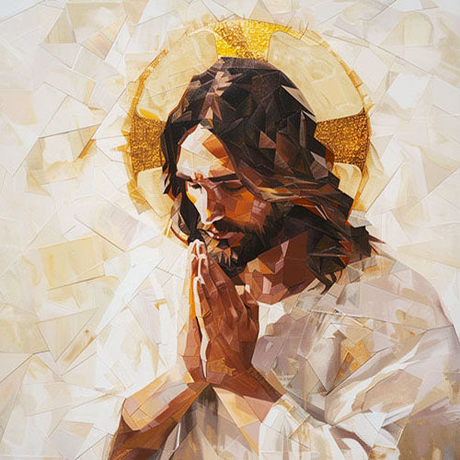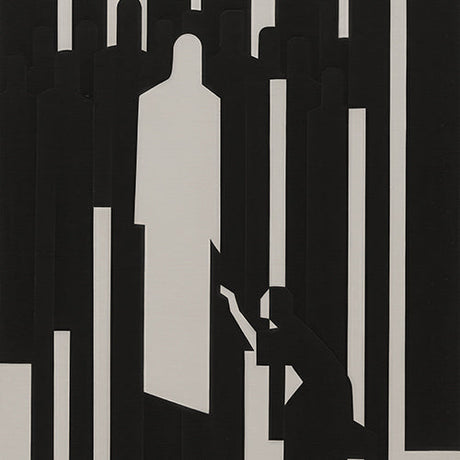From the earliest days of the Church to our contemporary digital age, religious artwork has acted as a conduit for faith, hope, and spiritual reflection. Whether a subtle minimalist cross or a vibrant Renaissance masterpiece, Christian imagery helps us connect with God on a deeper level.
At Faith Time Art, we believe the walls of your home are a canvas on which you can display the love of Christ, daily reminders of His promises, and a reflection of your most cherished beliefs. Our mission is to capture that love and present it in a modern, elegant way that resonates with your style.
Let’s journey through centuries of Christian art—from hidden symbols in catacombs to today’s minimalist paintings—and explore why these pieces still speak so powerfully to believers worldwide.
The Earliest Christian Artwork: Symbols of Hope in Hidden Places
A Legacy Born in the Catacombs
When we talk about the “first” Christian art, we’re referring to an era where believers often worshiped in secret due to Roman persecution. In the second and third centuries, Christians gathered in the Roman catacombs, underground burial corridors where they could practice their faith and, at times, leave behind symbolic artwork on the walls.

Christian Frescoes in Roman Catacombs
These paintings and carvings were simplistic, symbolic, and packed with meaning. For instance:

The Ichthys (Fish): A simple fish shape used by early Christians to identify fellow believers without attracting unwanted attention.

The Anchor: A symbol of steadfast faith, referencing Hebrews 6:19, which speaks of hope as the “anchor of the soul.”

The Good Shepherd: Depictions of a shepherd carrying a lamb, referencing John 10:11 (“I am the good shepherd”). These images served as comforting reminders that Christ tends His flock lovingly, even in times of trouble.
Though crudely executed compared to later masterpieces, these early works show the incredible devotion and creativity of believers who risked everything to practice their faith. Art was more than decoration—it was an act of worship and courage.
Personal Reflection in Secret Symbols
These hidden symbols allowed small Christian communities to affirm their faith together. They also laid the foundation for the Christian art tradition—one where imagery serves not only to instruct (especially in eras of widespread illiteracy) but also to comfort and inspire believers facing challenges.
Medieval to Renaissance: The Church as Patron of the Arts
The Rise of Iconography
Once Emperor Constantine granted Christianity legal status in the 4th century, Christians emerged from the shadows, and art began flourishing openly. The medieval period (approximately the 5th to the 15th century) saw the spread of icons, mosaics, and grand cathedrals adorned with intricate stained-glass windows.
-
Icons and Painted Panels: Common in Eastern Christianity, icons presented stylized and solemn images of Christ, the Virgin Mary, and the saints.

Protectress of the Roman People, Rome, 5th century. Icon of the Virgin Mary and Jesus
- Illuminated Manuscripts: Lavishly decorated biblical texts (like the Book of Kells) showcased swirling patterns, gold leaf, and vibrant pigments, transforming Scripture into visual storytelling.

"The Book of Kells" illuminated manuscript
These traditions set the stage for a broader acceptance of Christian imagery, making it not just a covert language of the persecuted but a central part of communal worship and devotion.
The Renaissance Explosion
By the 15th and 16th centuries, the Renaissance burst onto the scene, championed by legendary artists like Leonardo da Vinci, Michelangelo, and Raphael. The Church was often the greatest patron of the arts, commissioning:
- Altarpieces illustrating scenes from Christ’s life.

Renaissance Altarpiece
- Murals within chapels (Michelangelo’s Sistine Chapel ceiling is the crowning example).

Michelangelo’s Sistine Chapel ceiling
- Sculptures representing biblical figures in lifelike detail.

La Pietà by Michelangelo Buonarroti
This era transformed Christian art into something lavish and monumental, with classical humanism influencing depictions of biblical narratives. Christ was shown with more human emotion; Mary and the saints became deeply relatable figures.
The emphasis on biblical scenes—from the Nativity to the Last Supper and Resurrection—captured the imagination of believers, helping them visualize key moments of salvation history in vibrant color and near life-like realism.
Pro Tip: If you love classical grandeur but want a modern twist, check out our Jesus Paintings that blend timeless biblical imagery with a contemporary color palette. They pay homage to Renaissance drama without clashing in a sleek, modern interior.
Reformation and Baroque: New Directions in Religious Imagery
Shifts in Protestant and Catholic Realms
With the Protestant Reformation (16th century), religious art took different paths:
- In many Protestant communities, the use of extravagant images in worship spaces was curtailed to avoid what was seen as potential idolatry.
- In Catholic regions, however, art persisted as a vital devotional tool. The Counter-Reformation spurred the creation of even more grandiose and emotionally charged works meant to stir hearts toward piety.
Baroque Emotion and Drama
The 17th century’s Baroque period made Christian art dynamic, emotional, and theatrical:
- Caravaggio’s dramatic use of light and shadow (tenebrism) brought biblical events to life with stark realism.

The Calling of Saint Matthew by Caravaggio
- Bernini’s sculptures captured ecstatic moments of saintly vision, emphasizing direct emotional engagement.

Bust of Jesus Christ (17th Century) by Bernini
Across Europe, altarpieces, sculptures, and church architecture continued to proclaim biblical truths. This era cemented the notion that religious art could be deeply stirring—not only instructive but also capable of evoking powerful spiritual experiences.
The Rise of Modern Christian Artwork: From Realism to Abstraction
Industrial Revolution and Beyond
Moving into the 18th and 19th centuries, the world changed rapidly. Factories, new social movements, and a surge in secular philosophies influenced artists of all genres. Christian art increasingly appeared in smaller private forms—prints, small sculptures, personal Bibles with illustrations—rather than solely in grand church commissions.
Abstract and Minimalist Expressions
By the early to mid-20th century, many artists across the world embraced abstract expressionism and modern art movements that broke away from literal depiction. This shift also influenced Christian artists:
- Spiritual Abstraction: Some artists favored subdued palettes, geometric shapes, or swirling lines to convey spiritual truths.
- Symbolic Minimalism: A simple cross, a dove, or even a single beam of light in an otherwise abstract composition could speak volumes about faith.
Modern Christian art diverged from the hyper-realistic forms of previous centuries, focusing instead on emotional resonance and conceptual meaning. It’s from this lineage that many of today’s modern Christian wall art pieces draw their inspiration—turning the simplest of designs into a profound reflection of faith.

Modern Christian minimalsit art featuring art pieces: "Following His Grace", "Sermon on the Mount" and "Radiant Prayer"
Looking for a contemporary piece that fits flawlessly into a modern living room? Browse our Minimalist Christian Art and find a subtle yet powerful way to keep your faith at the forefront of your daily life.
Contemporary Trends in Christian Wall Art
Today, Christian wall art takes many forms:
- Realistic Paintings capturing iconic scenes like the Crucifixion of Jesus, Jesus Walking on Water, or Jesus embracing children.

Steps of Faith - Jesus Walking on Water Art
- Abstract Christian Art that relies on color, shape, and textures to evoke biblical themes of hope, resurrection, or divine love.

- Scripture-based Typography that features uplifting verses in elegant, modern fonts—turning words of life into stylish décor.
- Minimalist Line Art depicting silhouettes of biblical figures or symbolic elements like the cross or dove.
The beauty of the modern era is that you get to choose which style resonates with your personal faith journey. Whether you prefer more literal, narrative art or a quiet, introspective piece, there’s no shortage of options.
Reflecting Personal Devotion
One of the most potent reasons Christians choose to display religious art is the personal connection to a particular verse or story. Maybe you love the story of Jesus walking on water because it reminds you that He can calm any storm in your life. Or perhaps you cherish images of Christ with a lamb, recalling how He tenderly leads you and your family.
At Faith Time Art, we intentionally offer a range of designs to reflect the diversity of testimonies. From bold abstract pieces suitable for a chic loft to gentle watercolors perfect for a nursery, we encourage you to find the piece that “speaks” your story.
The Importance of Christian Art in the Home
Daily Reminders of His Presence
Life can get busy: early-morning commutes, soccer practices, grocery runs, never-ending to-do lists. In the flurry of daily life, Christian wall art stands as a quiet sentinel of faith, reminding you—and anyone who steps inside your home—of God’s enduring love.
- For Families with Children: A painting of Jesus with children can subtly reinforce biblical lessons and the value of compassion, patience, and hope.
- For Prayer Spaces: A minimalist cross in a personal prayer nook can help create a calming environment, focusing your heart and mind on Christ.

Christian wall art featuring art pieces (from left to right): "Jesus in the garden of Gethsemane", "Painting of Jesus walking on water" and "Jesus Leaves the 99"
Style Inspirations: Making Christian Art Complement Your Décor
Whether your interior design leans toward modern minimalism or cozy farmhouse, Christian wall art can enhance the ambiance. Here are a few style inspirations:
Modern Minimalist

- Color Palette: Soft whites, gentle beiges, and natural wood accents.
- Art Suggestion: Jesus with a lamb — a serene, minimal depiction of Jesus kneeling beside a lamb in a vast, open landscape.
- Why It Works: This gentle scene embodies the essence of modern minimalism: peaceful, purposeful, and uncluttered. The soft tones and open space in the artwork echo the calm and clarity of minimalist interiors, while the subject adds quiet emotional and spiritual depth.
Rustic Farmhouse

Following His Grace - Jesus Wall Art
- Color Palette: Warm neutrals—beige, cream, soft browns, and distressed wood textures.
- Art Suggestion: Following His Grace — a serene image of Jesus walking alone through a vast, quiet landscape, framed in natural wood.
- Why It Works: The peaceful solitude of the artwork mirrors the calm, reflective atmosphere of farmhouse decor. Its message of quiet trust and steady faith aligns beautifully with the homey, grounded values this style represents.
Boho-Chic
 "Sermon on the Mount" artwork in a boho home interior
"Sermon on the Mount" artwork in a boho home interior
- Color Palette: Warm neutrals, soft earth tones, and subtle organic textures.
- Art Suggestion: Artwork illustrating powerful spiritual moments, such as the Holy Spirit descending or Jesus teaching the crowds, displayed in minimalist natural wood frames.

Holy Spirit Art - Pentecost Moment artwork in a boho home decor
- Why It Works: The gentle color schemes and spiritual themes create a calming, reflective ambiance that aligns naturally with the serene and grounded essence of boho decor.
Contemporary Urban Loft

Sacred Sacrifice - Crucifixion of Jesus Artwork
- Color Palette: Industrial textures like exposed brick, metal fixtures, and bold accent colors.
- Art Suggestion: A large, dramatic piece—like a Crucifixion scene with expressive brushstrokes—emphasizing contrast and modern design.
- Why It Works: Urban lofts often feature large, open walls that can handle a statement piece. A dramatic scene underscores the raw, honest feel of the space.
Classic Traditional

- Color Palette: Rich woods, elegant fabrics, and timeless furniture.
- Art Suggestion: Jesus Praying in the Garden of Gethsemane that pays tribute to Renaissance art, framed in a refined, classic frame.
- Why It Works: Traditional spaces often invite pieces with depth and detail, evoking a sense of heritage and stability.
Conclusion: Elevate Your Home and Your Heart
Religious artwork has traversed centuries, empires, and countless cultural shifts, yet one theme remains steadfast: it’s all about glorifying God and connecting believers with the divine story of redemption.
From the humble fish sketch in a dark catacomb to the grand frescoes of the Renaissance, and now to sleek, minimalist canvases in a modern apartment, Christian art continues to teach, inspire, and uplift.
When you surround yourself with Christ-centered imagery, you create an environment where faith and family flourish. Each glance at the wall becomes an invitation to pause, reflect, and remember who you are in Christ.
At Faith Time Art, we’re honored to be part of that daily reminder. Each piece is designed to complement your personal style while boldly declaring the hope you carry in your heart. We invite you to browse our collections, discover pieces that resonate with your journey, and transform your home into a sacred, welcoming space.
Browse our Christian Wall Art Collection to explore timeless masterpieces and modern designs.

Thank you for joining us in this exploration of religious artwork. May your walls reflect the greatest truth we know: He is with us always. And may every piece of art you choose draw you closer to Him.
You might find these articles interesting:


